Yaw Akumasi Williams
Working as a Galamsey Miner
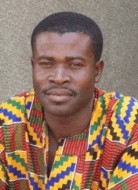 We
have a special term for the job that I have practised - with some interruptions
- since 1995, namely “Galamsey” mining, meaning small-scale mining. This word is
derived from Twi and now we modernise it to “Bodamsei” which literally means
‘madness’, because we are dirty [and thus we look like madmen] and it may also
be regarded as madness to neglect certain kinds of safety measures, for example,
not to put on safety suits for lack of money. Without a perfect protection of
our own, we “galamsey” people can only resort to the saying: “Jah-God (God) is
our protection”. Working underground is dangerous because
sometimes accidents occur, for example, broken stones may fall on your head, the
rain may wet the soil and lead to land-slides or you can slip into the hole
[shaft]. So everybody who goes down to work does so with carefulness, observing
the nature of the hole.
We
have a special term for the job that I have practised - with some interruptions
- since 1995, namely “Galamsey” mining, meaning small-scale mining. This word is
derived from Twi and now we modernise it to “Bodamsei” which literally means
‘madness’, because we are dirty [and thus we look like madmen] and it may also
be regarded as madness to neglect certain kinds of safety measures, for example,
not to put on safety suits for lack of money. Without a perfect protection of
our own, we “galamsey” people can only resort to the saying: “Jah-God (God) is
our protection”. Working underground is dangerous because
sometimes accidents occur, for example, broken stones may fall on your head, the
rain may wet the soil and lead to land-slides or you can slip into the hole
[shaft]. So everybody who goes down to work does so with carefulness, observing
the nature of the hole.
Starting to dig
In the process of digging we have about eight or more people in a group, which is made up of:
• One leader: He is in charge of the whole group.
• Three chisellers: Their duty is to dig and “chisel off” gold-bearing stones. They are also the
workers, who should know the directions and types of the gold-bearing rocks.
• Three “loco boys”: Their duty is to clean the hole. Any time the chisellers have dug some
waste they carry it out to provide space for the chisellers to continue their work.
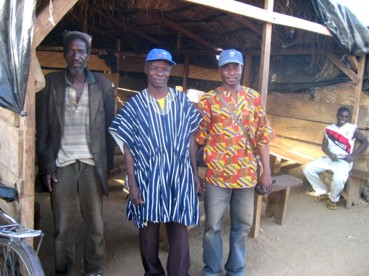 Fig. 2: Yaw (right) and members of the committee
Fig. 2: Yaw (right) and members of the committee
• One water carrier/cook: He cooks for the whole
group.
Before digging starts there are four steps we have to
go through:
1) We consult the overall leader (the person who
started digging at the area) for directives.
2) We consult the land owner of the area to seek
permission to dig.
3) We consult the village committee for registration
(see Fig. 2).
4) We consult the chief of the area.
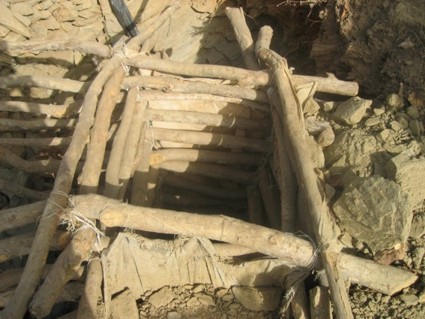
Fig. 3: Slabs
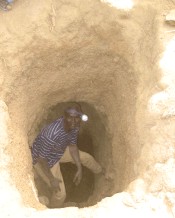 Fig. 4: In the shaft
Fig. 4: In the shaft
After going through the above procedure we acquire
a location, i.e. a place above the gold bearing stones
or rocks and then start to dig a narrow hole into the
earth to reach the rock which bears gold. The time
and hardship involved before reaching this rock
depend on the depth and the hardness of the earth
[the capping]. Sometimes we dig 20 or 30 feet down
before reaching the gold-bearing rocks. When we
meet a hard layer of rock we use dynamite to break
it open and to make the digging easier. As the great
depth of the hole makes it difficult to get in and out,
we put some wooden slabs [as casing; see Fig. 3] on the walls
so that we can step on them. We also call these wooden slabs
“chop-pass”. Although they are fixed on the wall they may
cause accidents when we step on them and they loosen. So we
always check them to see whether they are well fixed.
For digging, we use the following tools: pick-axes, shovels,
waste containers, loco-ropes [ropes with which containers are
drawn from the bottom of the shaft to the surface], flat chisels,
hammers, hoes etc. Before we can go down into the hole, we
have to provide a flash light with batteries and fix it on our
heads, to be able to see in the darkness of the pit (see Fig. 4).
Processing gold-bearing stones
First, we collect the gold-bearing stones, clean them from clay and leave them by the wall
until we see that it is a large quantity. Then we break them and crush
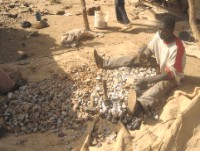 Fig. 5: Crushing
Fig. 5: Crushing
them into smaller pieces (Fig. 5), which are shared among the members of the gang
according to the job and amount of work each person does.
The leader takes more than the others, the next are the
chisellers, and the loco-boys receive the smallest quantity.
We also give some of the stones to the owner of the land,
the chief and committee members, who watch the place and
keep peace among all the workers of that site. To make sure
that nobody is cheated, we distribute the stones by
containers measuring approximately one bushel or about 20
to30 kg. Once we get a quantity of about 50 or more bushel
loads we use some of the stones to pay our dealers, from whom we borrow money in advance
to buy food and other items, for example, dynamite.
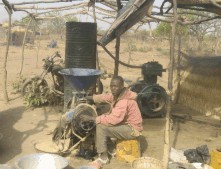 Fig. 6:
Grinding mill
Fig. 6:
Grinding mill
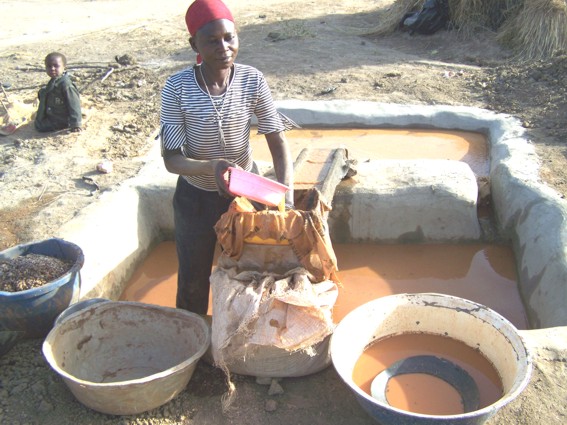
Fig. 7: At the washing board
After the stones have been crushed into smaller pieces,
pounded and ground (Fig. 6), the powdered stones are
washed on flat, long, wooden boards called washing
boards (Fig. 7). Blankets are spread on the board so that,
during the washing, little grains of gold dust remain
stuck on the blankets. After washing we shake the
blankets in a basin or pan. The container used for the
washing is called “bashing rubber”. It is the container
which the woman
in Fig. 7 is holding
in her hand. The bowl [of any type] we put the little
grains of gold dust in is called “videobowl”; the black
tube is called “sample tire” and the liquid used to bring
the little grains of gold dust together is called mercury.
After getting the whole bowl full of gold, we refine it in
fire and a yellowish colour is obtained. Then we weigh
it on a balance [with scales] or on computer [digital]
scales. Payments are made according to the weight
shown on the scales. A weight of gold equivalent to that of a razor blade fetches 15 Ghana
Cedis [less than 15 €].
My work as a Miner in Bolgatanga
Fourteen years ago I started doing “galamsey” business in Bolgatanga-Nangodi.
Early in 1995 I eye-witnessed a tragic episode when about 13 people were buried under the
rocks, and only one survived, while the remaining 12 were buried in the site. After they had
found gold near Nangodi, the indigenous Frafra did not want skilled miners to teach them. So
they dug trenches like gutters and when they continued to dig deeper and deeper into the
earth, the top broke off, fell on them and they had to die. As the group, with which I went
there, was somehow good in the job, we taught the others the better way, that is, cutting a
round hole into the earth and this was successful and safer.
I experienced another tragic event during the rainy season. Water had gathered in the holes
and we used some engines to pump the water out and as the pipes were short, we tried to put
the engines into the holes to get the water out. As the exhaust smoke of the generator was
very toxic, two of the operators died from it. I heard that many other people died in the same
way.
Working in Nangurma
Early in 2006 I started working in Nangurma (Komaland, N.R.) for five months (from April
to August 2006). There I had my first own gang made up of six boys (including myself): five
of them came from Wiaga, my own village (Lambo, Apirik, Akotibi, Achampong and myself)
and the other boy came from Nangurma. During my first stay in Nangurma with this gang,
each of us earned about five Ghana Cedis [then
approximately 5 Euros] within one month.
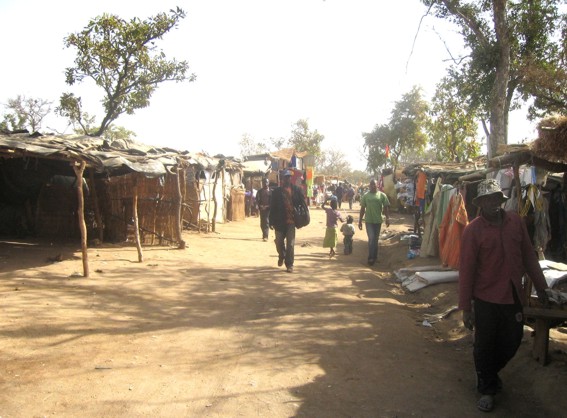 Fig. Fig. 8: Yaw in the market of Nangurma Gold Camp
Fig. Fig. 8: Yaw in the market of Nangurma Gold Camp
In the middle of May 2006, there was a dispute
between the Chief of Nangurma and the Mamprusi
over the ownership of land which nearly resulted into
an open conflict. We had to leave and stay away until
June 25th, 2006, when the chief of Nangurma and
Elders of Mamprusi had resolved their differences
and we were called back to continue our work.
Before we arrived there, other people had already
gone into our pit and had spoilt the pillars. There was nothing else to be done than quit the
pit. So the group was dissolved and each member went his own way. I formed another group
and started to dig another hole, where I hit a big rock, not a good one [not a gold-bearing
rock] and I wasted all the money I had earned before. I worked for four months and all this
time was a waste.
In this pit, I nearly had a bad accident when I almost fell into the hole myself. One day, I went
in to light dynamite and when I was rushing to come out before the explosion, I slipped from
a wooden slab [handhold] which broke before I realized I was hanging on another one which
saved me. Shivering and panicking, I got to the mouth of the hole when the dynamite
exploded. It might have been the most terrible day in my life.
I eyewitnessed the death of about seven people in my life and four people wounded by
accidents. I also witnessed one young man and woman drowning in a river during a heavy
downpour of rain. Another woman (a relative of my Yikpabongo friend), who prepared
Kooko for sale, lost her two-year-old son. He fell into the hot water which his mother had put
on the fire. The child was disfigured beyond recognition and died.
A Miner in Kadema
After experiencing all these things during the rainy season (in Nangurma) and the whole work
was at a standstill, we had to leave the place and planned to return after the rains had stopped.
But I made up my mind not to go there again, since there is gold in my own neighbouring
village of Kadema. I worked there in the late months of 2007 and the early months of 2008
and tried to dig my own hole.
Some years ago a company called Round [Rand?] Gold Ashanti had come to Kadema,
surveyed the land and proved that there was gold. We followed their directions and uncovered
[the capping]. Kadema is said to have a better gold quality than the other places, only the
earth [capping] is not strong so that accidents might easily happen. In the first period of work,
consisting of three months, I earned about four hundred Ghana Cedis (then approx. 400
Euros). During the busiest time, the Bulsa District Chief Executive, the Hon. Thomas Kofi
Alonsi, warned and called upon us to leave the place, because they thought we might spoil the
land. Working became bad, because everybody was rushing to get his share before quitting.
So we dug without caution. In this attitude a lot of boys got wounded and many more died.
The worst of all was that four boys were buried underground. It took us four days before we
were able to retrieve their bodies. Their names were: Ayomah from the Kadema Chief's
palace, Maxwell from Kadema, Amody from the Wiaga Chief's house and Ibrahim from
Nangurma-Centre (chief's house). The only one who survived in the group was Angmaami
(the grandson of Anamogsi, Anyenangdu Yeri, Wiaga). He could escape because, when they
were working together underground, they sent him to climb up and collect some tools (chisels
and hammers). When he came out he saw the clouds threatening rain. So he did not collect
the tools but went back into the hole to announce to them that there was rain. They should
stop work and continue after the rain. Ibrahim, the leader, anxious for money, instructed
Angmaami to bring the tools. So he tried to climb up (again). As he was coming out he
realized that water was filling the hole from above making the wall of the shaft slippery and
he found it difficult to get out (There was no casing in this shaft). But he persisted and was
able to get out. As soon as he had stepped out, water filled the hole. The [other] boys tried to
come out. But the pit was quickly filled with clay before we tried to rescue them. Then the
soil and stones fell on them and it was impossible to do anything.
The most painful thing was that there were two schoolboys in the group (Maxwell and
Amody). Some days before, Amody's mother (Maami) had come to the site to send him home
to continue his education. I helped his mother advising him. He agreed and went home with
her. After four days the boy came back again to the pit and I cautioned him, but what he told
me was: “I have come to earn some chop money [money for food]!” So I told him to do well
and go back after he had got some. On that same fateful day he joined the group and they
started work in an abandoned hole, where they had the tragic incidence. May their souls rest
in perfect peace. I know it is always good to pay heed to good advice, as there is a saying
“Had I known is always at last”.
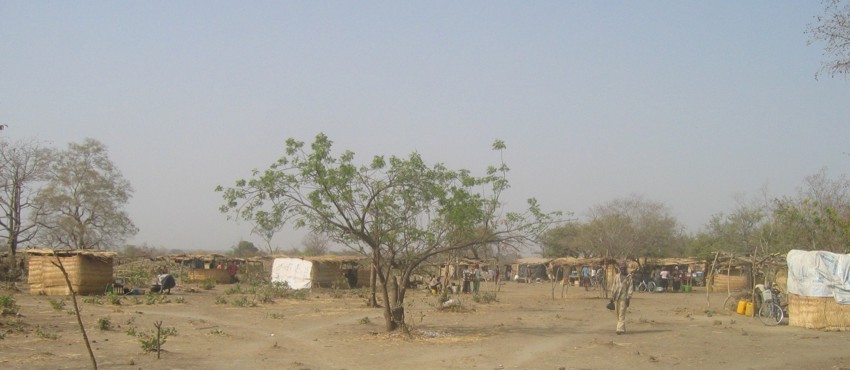 Fig. 9 The gold miners' camp in Kadema
Fig. 9 The gold miners' camp in Kadema
After all that I have said, you can still find the pits around these places mentioned. And they
serve as death traps. Until now there is no place where gold has been found without people
having died in accidents. So I call this job a “lose-gain-or-die” job.
 We
have a special term for the job that I have practised - with some interruptions
- since 1995, namely “Galamsey” mining, meaning small-scale mining. This word is
derived from Twi and now we modernise it to “Bodamsei” which literally means
‘madness’, because we are dirty [and thus we look like madmen] and it may also
be regarded as madness to neglect certain kinds of safety measures, for example,
not to put on safety suits for lack of money. Without a perfect protection of
our own, we “galamsey” people can only resort to the saying: “Jah-God (God) is
our protection”. Working underground is dangerous because
sometimes accidents occur, for example, broken stones may fall on your head, the
rain may wet the soil and lead to land-slides or you can slip into the hole
[shaft]. So everybody who goes down to work does so with carefulness, observing
the nature of the hole.
We
have a special term for the job that I have practised - with some interruptions
- since 1995, namely “Galamsey” mining, meaning small-scale mining. This word is
derived from Twi and now we modernise it to “Bodamsei” which literally means
‘madness’, because we are dirty [and thus we look like madmen] and it may also
be regarded as madness to neglect certain kinds of safety measures, for example,
not to put on safety suits for lack of money. Without a perfect protection of
our own, we “galamsey” people can only resort to the saying: “Jah-God (God) is
our protection”. Working underground is dangerous because
sometimes accidents occur, for example, broken stones may fall on your head, the
rain may wet the soil and lead to land-slides or you can slip into the hole
[shaft]. So everybody who goes down to work does so with carefulness, observing
the nature of the hole.





 Fig. Fig. 8: Yaw in the market of Nangurma Gold Camp
Fig. Fig. 8: Yaw in the market of Nangurma Gold Camp